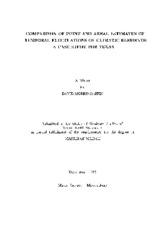| dc.creator | Gaffin, David Morris | |
| dc.date.accessioned | 2012-06-07T22:31:34Z | |
| dc.date.available | 2012-06-07T22:31:34Z | |
| dc.date.created | 1993 | |
| dc.date.issued | 1993 | |
| dc.identifier.uri | https://hdl.handle.net/1969.1/ETD-TAMU-1993-THESIS-G131 | |
| dc.description | Due to the character of the original source materials and the nature of batch digitization, quality control issues may be present in this document. Please report any quality issues you encounter to digital@library.tamu.edu, referencing the URI of the item. | en |
| dc.description | Includes bibliographical references. | en |
| dc.description.abstract | Because of the accepted practice of using single point estimates to represent large areas of the world (especially in Africa and South America), an attempt was made to assess the amount of error involved in using a single point estimate (station) to represent a large area such as a climatic division, as well as the state of Texas. Stations used in this study were selected on the basis of a long continuous record (preferably >50 years), minimal number of station moves (none over a mile), non-urbanized locations (populations <25,000), and adequate spatial coverage in order to evaluate the best possible data in terms of homogeneity. It was determined that since a product-moment correlation coefficient of > 0.86 causes at least a 50% reduction in the standard error of estimate, [](1-r2)this was a value that was practically significant in determining a 'representative' area. Station-to-station correlations versus distance graphs were then evaluated along with isopleth maps of correlations between a single point estimate and the statewide and divisional average a real estimates in order to further assess the size and seasonality of the 'representative' area for Texas. The results indicated that January experienced the highest correlations with July the lowest for both temperature and precipitation series. This was attributable to the fact that synoptic scale systems dominate during the winter while isolated convection dominates during the summer. While temperature revealed a highly correlated and centered areal estimate, precipitation revealed that the area of highest correlations was biased towards areas of persistent and reliable rainfall. Even when evaluating the results of this study with correlation thresholds of >0.50 and >0.33, as was done with earlier studies of annual temperature series, the size of the I representative' area for Texas was not as large as would have been assumed by the earlier studies. | en |
| dc.format.medium | electronic | en |
| dc.format.mimetype | application/pdf | |
| dc.language.iso | en_US | |
| dc.publisher | Texas A&M University | |
| dc.rights | This thesis was part of a retrospective digitization project authorized by the Texas A&M University Libraries in 2008. Copyright remains vested with the author(s). It is the user's responsibility to secure permission from the copyright holder(s) for re-use of the work beyond the provision of Fair Use. | en |
| dc.subject | meteorology. | en |
| dc.subject | Major meteorology. | en |
| dc.title | Comparison of point and areal estimates of temporal fluctuations of climatic elements: a case study for Texas | en |
| dc.type | Thesis | en |
| thesis.degree.discipline | meteorology | en |
| thesis.degree.name | M.S. | en |
| thesis.degree.level | Masters | en |
| dc.type.genre | thesis | en |
| dc.type.material | text | en |
| dc.format.digitalOrigin | reformatted digital | en |


